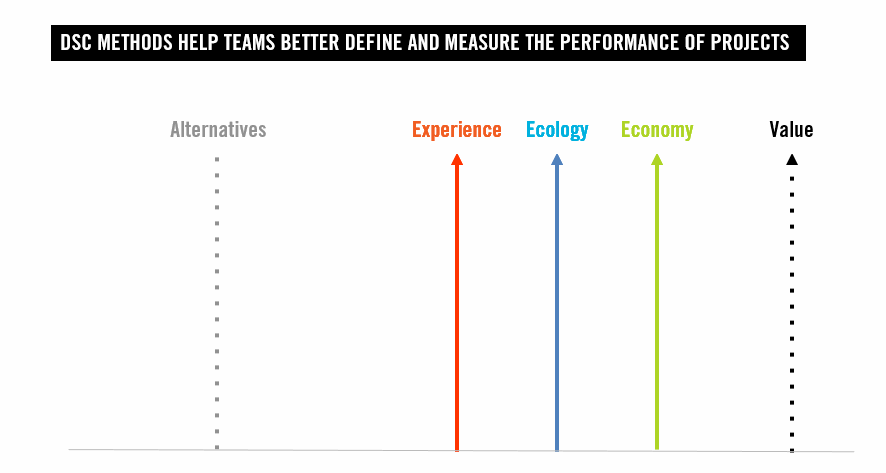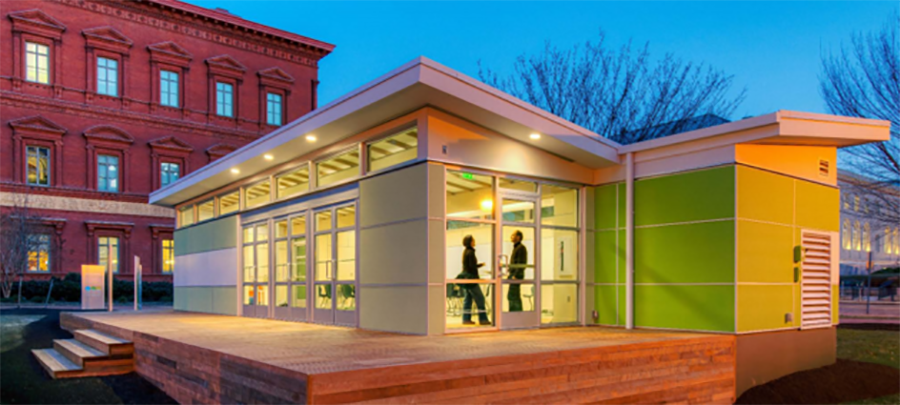Overview
To make complex decisions with confidence, teams need to efficiently process a great deal of rationale. They must assemble relevant Stakeholders, define Goals, generate Alternatives, perform Analyses, assess Trade-offs, and make Decisions. A Design Space model interrelates this information.
Maximize Value
The design is a decision making process. Performance-based design seeks to maximize the value of those decisions. Value maximizes by formulating and executing a process of understanding project constraints and goals of stakeholders; generating and analyzing alternatives; and evaluating tradeoffs that meet constraints lead to promising alternatives that maximize performance.
Design theory often describes Stakeholder value in terms of experiential, ecological and economical factors. For a relocatable classroom building, for example, experiential factors may include the aesthetics, thermal comfort, teaching space effectiveness, and views afforded by the space. Environmental factors may include how much energy or water the structure consumes through its life cycle. Economic factors may include how much the building costs to construct and operate. Different stakeholders may have different priorities over these objectives. Different alternatives may preform better or worse on each factor. Design team must somehow combine these performance objectives and stakeholder priorities into a value equation that orders alternatives. Figure 1 describes these concepts using a parallel coordinates plot.
 Figure 1: Design teams construct ad hoc design spaces
Figure 1: Design teams construct ad hoc design spaces
Of course, all performance-based design teams construct and explore design spaces to some extent today. However, we typically use ad hoc processes and tools that do not clearly define performance metrics, alternative spaces, performance data, and decision rationale. To illustrate this point graphically, we draw the lines in Figure 1 dashed. Such unsystematic design process lead to inefficient design exploration, and loss of value.
Construct and Explore Clear Design Spaces
Emerging parametric design, analysis, and optimization tools make it possible to clearly construct and systematically explore design spaces. Figure 2 illustrates these clearer objectives, metrics, alternatives and value equations, and how they can enable teams to more systematically explore the space and achieve greater value, using solid lines:

Figure 2: This curricula teaches design teams to construct, explore, and communicate design spaces to maximize value
In order to construct, explore, and communicate Design Spaces, Teams need to learn how to work together to leverage these new tools. Specifically, design teams need to learn to execute a systematic, collaborative, iterative process of:
- Decision Formulation - where design teams and stakeholders work together to define the performance metrics and range of alternatives they are interested in exploring.
- Alternative Generation - where computational designers define parametric and generative systems capable capable of defining a range of alternatives likely to maximize value.
- Performance Analysis - where performance specialists analyze the alternatives for experiential, ecological, and economic performance.
- Data Analysis and Decision Making - where data scientists and decision makers analyze this data, understand sensitivity and trade-offs, and make and communicate decisions.
This curriculum teaches this process through a specific case study, the specification of design parameters for a relocatable classroom design called Sprout Space,and its optimization for energy, daylight, and view considerations. Figure 3 shows an image of a sprout space building.

Figure 3: A Sprout Space Design, as constructed.
Download Resources
| Resource | Description | Weblink | |
|---|---|---|---|
| Grasshopper plugin | Parametric Modeling for Rhinoceros | Download | |
| GH file | Sprout Space GH Definition | Download | |
| Zip file | Package of all the required resources | Download | |
| epw file | Weather Data, Los Angeles, CA | Download |
Credits
John Haymaker
Perkins + Will Research Director
[email protected]
Marcelo Bernal
Researcher | Universidad Técnica Federico Santa María - Chile
[email protected]
Justin Brechtel
Senior Computational Designer | P+W Los Angeles
[email protected]
Santiago Diaz
Senior Computational Designer | P+W Vancouver
[email protected]
Luc Deckinga
Digital Practice Manager | P+W San Francisco
[email protected]
Hakim Hasan
Architect I | P+W Atlanta
[email protected]
Tyrone Marshall
Researcher and Architect | P+W Atlanta
[email protected]
Victor Okhoya
Senior Researcher + Design Application Manager | P+W Vancouver
[email protected]
Andrew Salveson
Design Application Manager | P+W New York
[email protected]
Anton Szilasi
Energy Strategist | P+W Dallas
[email protected]
Patrizia Kuehn
Architect I | P+W San Francisco
[email protected]